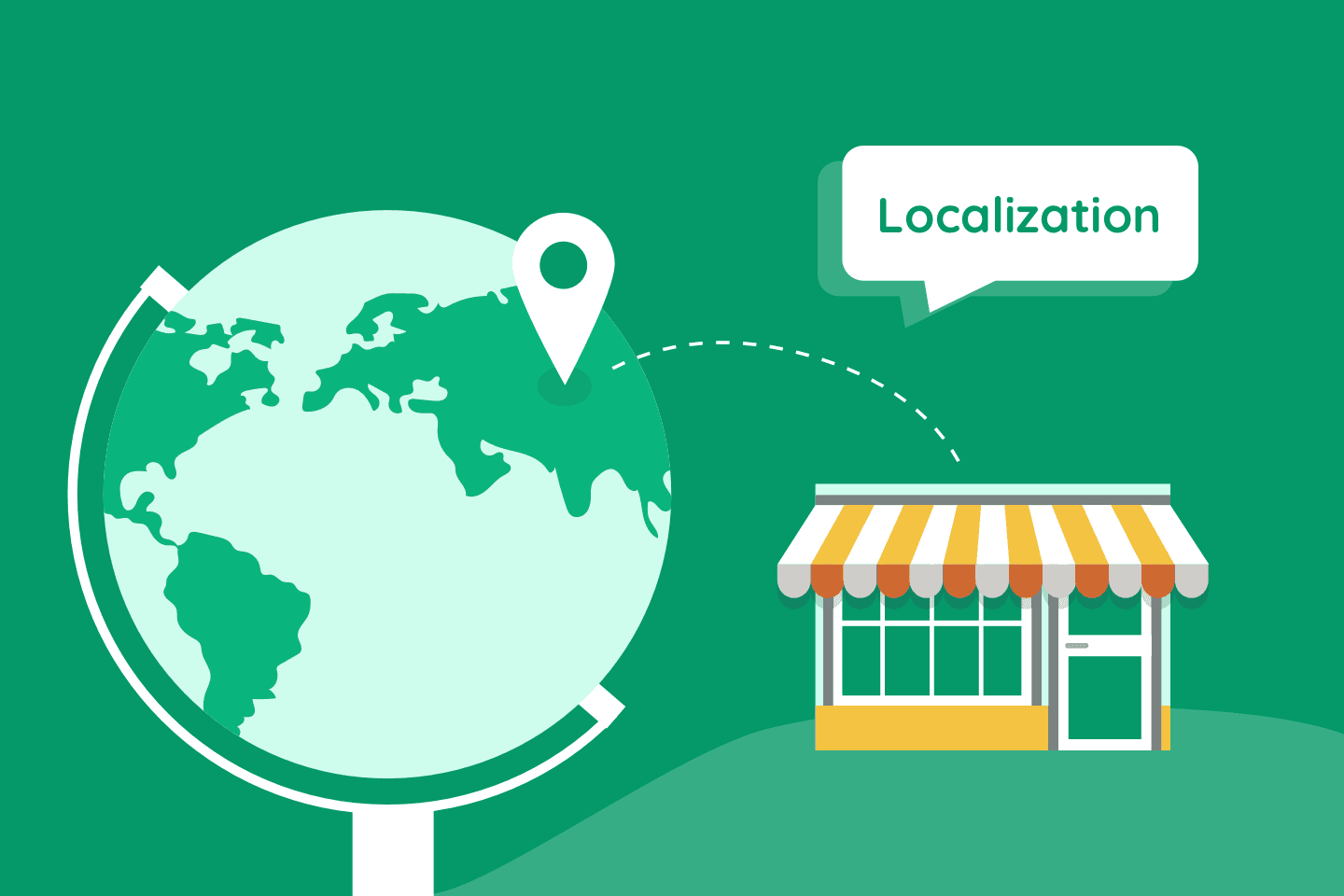As your eCommerce store grows and evolves, you’ll probably venture into serving different markets and segments. After all, when you restrict yourself to doing business in your home country (say, the US), you’re basically selling yourself short, and leaving money on the table.
So: stay in your home country… or start serving buyers from across the world? The answer is obvious.
That said, venturing into a new market is easier said than done. Consumers in China don’t consume content, search for products, and shop the same way as consumers in the US. The same goes for consumers in Europe, the Middle East, or whichever geographical region you’re thinking of expanding to.
Now, here’s where localization comes in. With localization, you can adapt your products and messaging to each new market you’re launching in, and in turn, make your brand more relevant to your consumers.
In this guide, we discuss all you need to know about localization. Read on to find out more!
What is localization?
In a nutshell, localization refers to the modification of a business or asset to cater to a specific target market.

Here, your goal is to tweak your asset to make it more relevant to your target audience. For example, if you’re trying to break into the Asian market, but your website exclusively features stock images with Caucasian models, there’s obviously a misfit there.
Localization, internationalization, and globalization: an overview
Two concepts that are intrinsically linked to localization are internationalization and globalization.
First up, globalization is defined as the “spread of products, technology, information, and jobs across national borders and cultures”. Basically, globalization refers to the interdependence of nations and involves the various world economies becoming more interlinked and connected.

Falling under the umbrella term of globalization are internationalization and localization. You already know what localization is; internationalization, on the other hand, refers to the act of engineering certain assets (products, applications, websites, etc) in a way that allows them to be easily localized.
For instance, when building a website, you might choose to use tools that support international character sets. When designing the layout of your page, you might allocate extra space as a buffer of sorts, in case more space is needed after your website copy is translated into a different language.
What localization means in business
Localization is important regardless of what sector you’re in, but it’s exceptionally crucial for eCommerce business owners.
In other words: if you don’t localize your website and eCommerce store when entering a new market, you’re setting yourself up to fail.
Why is localization important?
Localizing your content and site brings a lot of benefits to the table, including:
- Finding new opportunities
- Growing revenue
- Building closer customer relationships
- Providing a better experience
In this section, we’ll walk you through how you can use localization to achieve the above.
Benefits of going local after you go global:
#1 – Find new opportunities
If you identify a growing market to tap on, and successfully localize your content, this represents an enormous opportunity for you to boost your sales revenue.
For example, say you’re a Korean skincare brand (based in Korea). In Korea, there are a million and one skincare companies, and competition is stiff. So instead of focusing on competing locally, you might decide to serve customers in the US, where demand for Korean skincare is growing pretty rapidly:

All things being equal, you might find it easier to grow your revenue from customers in the US, and scale your business from there.
#2 – Grow revenue
We’ve discussed this previously, so we won’t dwell much on it. Basically, if your revenue has plateaued for quite some time now, entering a new market (and exposing your brand to new customers) is a great way for you to grow your revenue.
#3 – Build closer customer relationships
If you’re speaking and liaising with your customers in a language that they’re not 100% comfortable in, they’ll always be some sort of barrier there.

On the flip side, when you localize your content and adapt your content for your different markets, you’ll reduce any friction that’s present, allowing you to build closer customer relationships. Hopefully, you’ll be able to engage and retain your customers more effectively, thereby increasing your customers’ Lifetime Value (LTV).
#4 – Provide a better experience than your competitors
This one’s fairly straightforward: if your competitors don’t localize their product/website, and you do, this automatically gives you a leg up.
Picture this: you’re shopping for a new pair of boots, and you’re looking at two sites — Site A and B. You can understand all the information on Site A (including product information, shipping FAQs, return policy, etc), but Site B is written in a different language, and while you can use Google Translate, this doesn’t provide an accurate translation. Who will you purchase from?
The answer is obvious!
The right localization strategy for retail businesses
For retail or eCommerce stores, a successful localization strategy comprises of the seven elements that we’ve outlined below.
#1 – Internationalization
As mentioned previously, internalization refers to the act of engineering certain assets (products, applications, websites, etc) in a way that allows them to be easily localized.
Now, once you’ve built your website, it’s hard to go back and edit the code so that your site can be localized. Bearing this in mind, always plan ahead. More specifically, make sure that your site is built in a way that allows it to be adapted, EVEN if you don’t think you’ll expand to overseas markets in the foreseeable future.
#2 – The Translation of Content
When you do decide to expand into new markets, the first thing you’ll want to do is to translate the content on your site. If you have thousands of SKUs and product pages on your site, this might take some time, so kickstart the process as soon as possible.

For those who want to outsource translation, you can look for freelance translators on job sites such as Upwork. If possible, get a member on your team or personal contact to vet the work, and make sure that the translations are accurate. Sloppily translated product descriptions and/or website copy won’t inspire confidence in the new customers that you’re hoping to reach out to.
#3 – Currency
When you localize currencies for your target audience, this increases your conversion rates, and (potentially) boosts your growth.
Thankfully, localizing currencies is pretty simple. All you have to do is use a shopping cart that supports, say, the 30 most popular global currencies. Leading shopping carts such as Shopify, Magento, and BigCommerce all do this.
#4 – Payment Methods
Popular payment methods differ from country to country. Here’s a handy breakdown:

If you want to cater to customers in Russia, for example, and you don’t offer payment by QIWI, you’re starting at a disadvantage. Bearing this in mind, make sure you’re equipped to allow your customers to pay via their favorite gateway before you launch in a new market. Also, to prevent unvoluntary churn make sure you have a set process for tracking payments and card payment faillures.
#5 – Shipping
Ideally speaking, your website should automatically calculate shipping times and fees based on your customer’s location. For example, Amazon does this well:

And so does clothing eCommerce brand Tobi:

What happens if you don’t provide enough information about shipping on your product pages?
If your customer really likes your products, they might hunt down your “Shipping” page and read the fine print to get more information; if not, they’ll churn and purchase from your competitor instead.
#6 – Taxes and Regulations
Taxes and regulations are a headache to think about, but it’s important to get these right if you intend to expand into other markets.
What exactly should you do here? Firstly, read up on the policies and regulations of the market you want to sell to, and make sure you’re not selling any prohibited items. In certain cases, you might face an easy yes/no situation (ie: you’re either allowed to sell, or you’re not allowed), but there are also many grey areas where companies CAN sell as long as they’re compliant with labor laws, environmental regulations, and more.
Goods like liquor, weapons, medicine, and food are often restricted and/or regulated by governments, but that aside, many governments also restrict the sale or import of seemingly harmless items, such as:
- Beauty products
- Tableware
- Cosmetics
- Glazed pottery
- Jewelry
- Playing cards
- Silk
- Straw hats
- Watches
- Woven fabrics
On top of that, read up on the taxes associated with your target regions, and ensure that you understand exactly how much you’ll have to pay (and how to go about doing it). If a certain territory is highly taxed, you might realize that serving this market isn’t that profitable for you after all.
#7 – Customer Support Options
Consumers from different countries don’t just shop differently — they have different expectations when it comes to customer support as well.
On top of that, consumers from across the globe also differ in their channel preferences. For instance, Asian consumers like to resolve problems online, but South Africans prefer calling in to resolve a problem.
Bearing this in mind, make sure you do your due diligence, and adapt your customer support strategy for the market you’re launching in.
Localization strategy example
In considering all of the above factors, here’s an example of how an eCommerce company might localize their business when launching in a foreign country:
Internationalization
Ensure that applications, websites, product pages are built in a way that allows them to be easily localized.
Translation of content
Hire translators to translate the entire website into a local language. Cross-check the work and ensure that translations are accurate.
Currency
Use a shopping cart that supports major currencies from across the world. Prices on the website should automatically be reflected in the customer’s home language.
Payment methods
Allow customers to pay via their favorite payment gateways. In developing countries such as India, consider offering cash on delivery, which is a preferred mode of payment.
Shipping
Automatically calculate shipping times and fees based on your customer’s location. Don’t make them dig through your website to find your shipping policy.
Taxes and regulations
Read up on the policies and regulations of the market, and make sure you’re not selling any prohibited items. Conduct research about the taxes in your target market, and ensure that you understand exactly how much you’ll have to pay (and how to go about doing it).
Customer support options
Adapt your customer support strategy (the channels you offer, the number of reps you have on hand, etc) to the market you’re in.
What is localization? A final word.
You’ve made it all the way to the end of our guide, and you’re now a bona fide expert on localization and its importance. Give yourself a pat on the back!
If there’s one takeaway that you get from this blog post, let this be it — in this day and age, localization is no longer a nice-to-have; it’s a must-have.
Globalization has led to stiff competition, regardless of which industry you’re in, and if you want to outperform your competitors and win over your customers for life, then you’ll definitely have to tap on the power of localization.
Have you localized your business for the new markets that you’re entering? What strategies are you using to localize your business? Let us know in the comments below!




